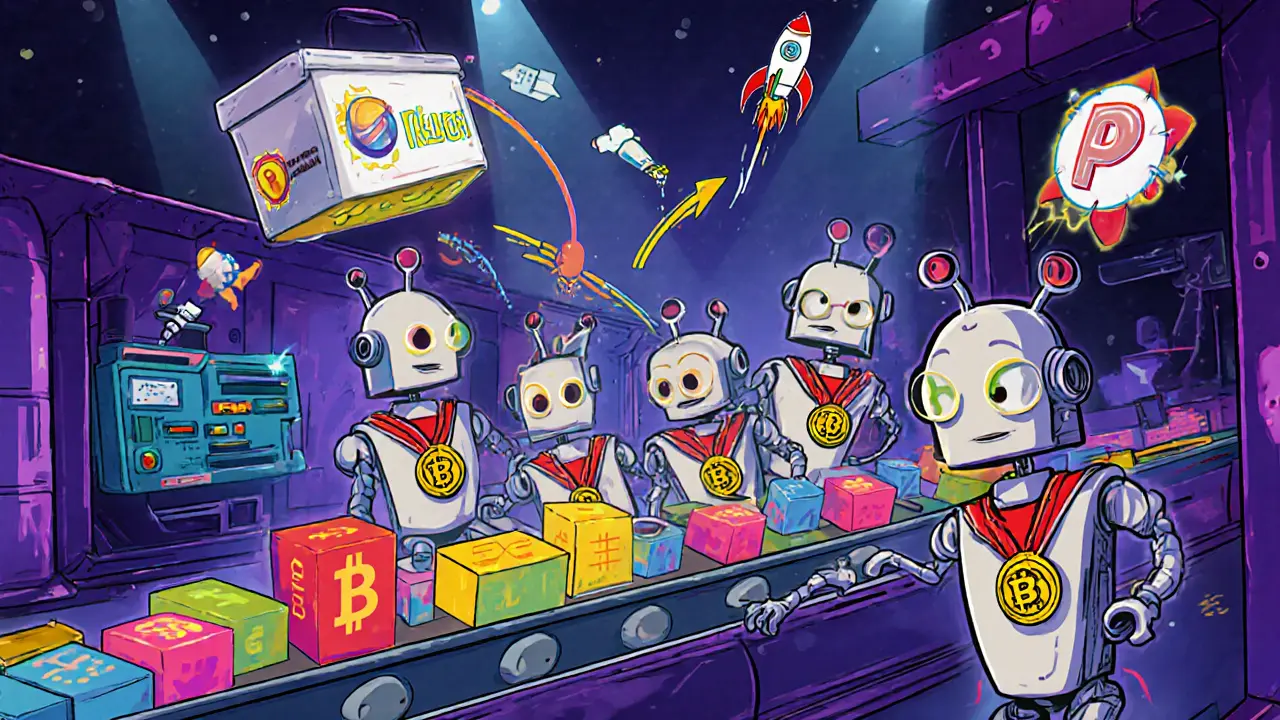RFUEL Token Value Calculator
Current RFUEL Metrics
Price: $0.0015
Market Cap: $322,000
Circulating Supply: 224,540,000
24h Change: +1.69%
30d Change: +20.5%
1y Change: -69.4%
Investment Simulator
Projected Results
Ever wonder what the buzz around RioDeFi actually means for a regular investor? In a market flooded with new coins, RioDeFi (RFUEL) stands out thanks to its own blockchain, RioChain, and a promise to link traditional finance with DeFi. This guide breaks down the token’s purpose, the tech under the hood, recent price action, and whether it’s worth a closer look in 2025.
What Is RioDeFi?
RioDeFi is a blockchain technology company that created the RFUEL token as the native utility token for its RioChain network. Launched in 2020, the project set out to accelerate mass adoption of digital assets by acting as a bridge between traditional finance and decentralized finance (DeFi). Its core value proposition is cross‑chain interoperability - the ability to move assets smoothly between Bitcoin, Ethereum, and other ecosystems without relying on centralized exchanges.
RioChain Architecture
The backbone of RioDeFi is RioChain, a next‑generation blockchain built on the Parity Substrate framework. Substrate gives developers a modular kit to customize consensus, runtime logic, and governance. RioChain leverages this flexibility to secure compatibility with the Polkadot ecosystem, allowing it to act as a parachain‑compatible network.
Consensus runs on a Proof of Authority (PoA) model. Trusted validator nodes, rather than anonymous miners, create blocks every two seconds. This design yields:
- ~3,000+ transactions per second
- Transaction fees under $0.001
- Energy consumption roughly 1/100th of proof‑of‑work chains
Because PoA relies on a limited set of vetted validators, RioChain can guarantee fast finality while still offering decentralization through a transparent validator selection process.

RFUEL Token Economics
The RFUEL token serves three primary roles:
- Paying transaction fees on RioChain
- Staking collateral for validators
- Incentivizing developers who build on the network
Key supply figures (as of October 2025):
| Metric | Value |
|---|---|
| Maximum Supply | 1,000,000,000 RFUEL |
| Circulating Supply | 224,540,000 RFUEL |
| Market Capitalization | ~$322,000 |
| Current Price (Oct2025) | $0.0015 USD |
| All‑Time High | $0.263 (Sept2020) |
Distribution was designed to avoid sudden dumps. At the Token Generation Event (TGE), 38.89% of private‑sale tokens were released, followed by a 1‑day cliff and 10.2% monthly unlocks. Team and advisor allocations have a 6‑month cliff and then 5.56% monthly releases. Staking rewards are scheduled to taper off by the end of 2025, while the reserve pool releases a modest 0.0494% daily after a 12‑month cliff.
2025 Market Performance
RFUEL’s price trajectory has been brutal. From its $0.263 peak, the token slid to a low of $0.00062 in April 2025 before inching back to around $0.0015. The 24‑hour gain is +1.69%, with a 30‑day rise of +20.5%, but the year‑to‑date change remains a -69.4% drop.
Liquidity is thin: daily trading volume hovers between $22,500 and $26,000, reflecting a market cap that barely clears $300k. The Fear & Greed Index sits at 48 (neutral), while the 14‑day RSI is 50.7, indicating no clear overbought or oversold condition. Volatility is modest at 4.37%.
Short‑term price models from CoinCodex predict a rise to $0.00179 by early October 2025 - an 18% bump. Longer‑term outlooks for 2026 expect a range of $0.00106-$0.00138, suggesting a sideways market rather than a dramatic rally.
Risks and Considerations
Investors need to weigh several red flags:
- Micro‑cap status: A market cap under $500k makes the token highly susceptible to price manipulation.
- Limited exchange listings: Low liquidity can cause sizable slippage on even modest trades.
- Competitive landscape: Established cross‑chain players like Polkadot, Cosmos, and Chainlink dominate developer mindshare.
- Adoption uncertainty: Despite solid tech, real‑world usage metrics (e.g., active addresses, transaction volume) remain scarce.
These factors combine into a high‑risk, high‑reward profile. If RioDeFi can secure strategic partnerships or showcase a thriving DeFi ecosystem on RioChain, the token could see renewed interest. Otherwise, further price erosion is plausible.

How to Acquire and Store RFUEL
For those still curious about buying, RFUEL can be found on a handful of smaller exchanges (e.g., KuCoin, Uniswap V3 pairs). The typical steps are:
- Create an account on a supported exchange and complete KYC if required.
- Deposit fiat or a major crypto (BTC/ETH) into your exchange wallet.
- Trade the base currency for the RFUEL pair.
- Withdraw the tokens to a non‑custodial wallet that supports ERC‑20 assets (MetaMask, Trust Wallet) - RFUEL is an ERC‑20 token on the Ethereum network, despite its native RioChain origin.
Storing in a hardware wallet (Ledger or Trezor) adds an extra layer of security, especially given the token’s low liquidity and potential for exchange hacks.
Future Outlook and Predictions
Looking ahead, RioDeFi’s success hinges on three milestones:
- Network adoption: A measurable increase in daily active addresses and DeFi contracts on RioChain.
- Partnerships: Integration with existing DeFi aggregators or institutional gateways.
- Roadmap delivery: Completion of the staking rewards schedule and the rollout of a user‑friendly wallet app announced for Q42025.
If these checkpoints are met, the token could gradually climb out of the micro‑cap zone, potentially reaching $0.002-$0.003 in the next 12‑18 months. Absent tangible progress, the token may remain a speculative niche, vulnerable to delisting.
Frequently Asked Questions
What is the primary purpose of the RFUEL token?
RFUEL pays transaction fees on RioChain, acts as staking collateral for validators, and rewards developers who build applications on the network.
How does RioChain achieve cross‑chain interoperability?
Built on Parity Substrate, RioChain uses Polkadot’s XCMP (Cross‑Chain Message Passing) protocol to send and receive assets from other blockchains without a centralized bridge.
Is RFUEL an ERC‑20 token?
Yes. Although RFUEL powers the native RioChain, the token is issued as an ERC‑20 on Ethereum for easier listing and wallet compatibility.
What are the main risks of investing in RFUEL?
Key risks include low market cap, limited liquidity, strong competition from larger cross‑chain platforms, and uncertain real‑world adoption of RioChain.
Where can I buy RFUEL safely?
Currently, RFUEL is available on a few mid‑size exchanges such as KuCoin and via decentralized swaps on Uniswap V3. Always transfer to a personal wallet after purchase.

RFUEL still feels like a micro‑cap ghost wandering the DeFi desert.
The hype around tiny tokens like RFUEL is nothing short of financial irresponsibility, and it disgusts me to see people chase these pipe dreams.
We need to stop glorifying speculative assets that exist solely to feed the ego of opportunistic developers.
Every ounce of capital shoved into such micro‑caps could be better used supporting real technology that benefits society.
Investors have a moral duty to demand transparency and sustainable value, not glossy whitepapers.
Wake up and demand real utility before you get burned.
The RFUEL token, as presented, exemplifies the archetype of a speculative micro‑cap seeking relevance through technological rhetoric.
Its underlying RioChain, while architecturally sound owing to Substrate's modularity, does not intrinsically guarantee network effects.
Moreover, the PoA consensus, despite offering sub‑second finality, introduces a centralisation vector that contradicts the decentralised ethos professed by many DeFi projects.
The tokenomics, with a maximum supply of one billion and a circulating supply that constitutes merely a quarter of that figure, suggest a potential for future inflationary pressure.
Furthermore, the staged release schedule, including monthly unlocks for private‑sale participants, may precipitate periodic sell‑offs.
Liquidity, as evidenced by daily volumes hovering near twenty‑five thousand dollars, remains insufficient to absorb even modest market orders without slippage.
This paucity of depth renders the price vulnerable to manipulation, a risk amplified by the token's sub‑500‑k market cap.
In addition, the competitive landscape populated by Polkadot, Cosmos, and established bridges presents a formidable barrier to adoption.
Absent a clear, quantifiable increase in active addresses or DeFi contracts on RioChain, the network's utility remains largely theoretical.
The recent price trajectory, descending from an all‑time high of $0.263 to approximately $0.0015, reflects a broader market correction rather than project‑specific fundamentals.
While short‑term models predict modest rebounds, they rely on assumptions of renewed investor confidence that are not substantiated by current on‑chain metrics.
Strategic partnerships, should they materialise, could serve as catalysts, yet the project's roadmap provides no concrete milestones beyond a wallet app slated for Q4 2025.
Consequently, the risk‑reward profile skews heavily toward risk, demanding thorough due diligence from any prospective holder.
Investors must also contemplate the regulatory environment, as ERC‑20 tokens on Ethereum remain subject to evolving legal scrutiny.
In sum, the token's promise is alluring in abstract, but the tangible evidence to date does not convincingly support a bullish thesis.
Honestly, the price dip looks scary, but the tech could still pull through.
Keep an eye on validator activity before you jump in.
Everyone talks about RioDeFi like it's a hidden gem, but they don't mention the secret backroom deals that keep the token afloat.
There's a whole network of insiders moving RFUEL before the public even knows it exists.
If you ask me, the whole thing feels orchestrated, and the price predictions are just a smokescreen.
Stay skeptical and protect your funds.
Nice points! Even if the market is shaky, the community vibe around RioChain is genuinely hopeful.
Let's keep encouraging developers; a vibrant ecosystem could shift the odds.
From a cultural perspective, the ambition to bridge traditional finance with DeFi reflects a global desire for inclusive financial services.
Many emerging markets lack robust banking infrastructure, and projects like RioDeFi could fill that void if they achieve real adoption.
However, the token's current scarcity of active users suggests it's still early in its adoption curve.
Education and localized partnerships will be crucial for gaining trust in regions where crypto is still viewed with suspicion.
Regulatory clarity will also play a pivotal role; without it, potential users may remain hesitant.
Overall, the concept is promising, but execution will determine success.
Exactly, Heather – building that trust takes time, but the community can make it happen.
Let's stay supportive and share resources.
RFUEL is probably a front for a larger scheme to siphon investor money.
They'll pump it just enough to get you in, then dump.
Don't fall for it.
Haha, Kate, that’s a classic crypto vibe.
Just keep doing your own research.
From a technical standpoint, the PoA consensus reduces block propagation latency, which is beneficial for high‑frequency transaction workloads.
However, the validator set's limited size may introduce centralization risk, affecting network resilience.
Liquidity fragmentation across multiple DEXs further complicates arbitrage opportunities.
Overall, the architecture is solid, but market dynamics remain the primary hurdle.
One must consider the existential implications of tokenizing finance; is RFUEL merely a conduit for speculative fervor, or does it embody a deeper shift in value perception?
Perhaps the true significance lies not in price, but in the collective narrative that binds participants together.
In that sense, even a micro‑cap can wield disproportionate influence on community sentiment.
Nevertheless, we must remain vigilant against hallucinated optimism that blinds us to systemic fragility.
Thus, balance skepticism with curiosity.
The hype train is moving fast, but the fundamentals are lagging.
Don't get caught up in the noise.
Ah, another token promising the moon while delivering a penny.
Classic DeFi romance.
Enjoy the ride.
i get why people are curious about RFUEL, it's kinda cool how they try to link old finance with new.
but honestly, the risk feels huge right now.
maybe wait until they show more real usage before diving in.
stay safe out there!